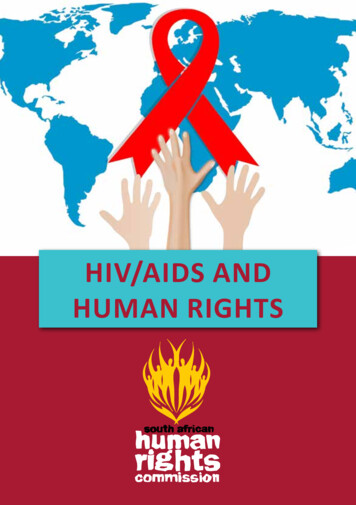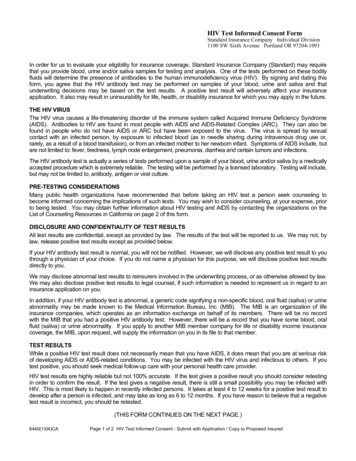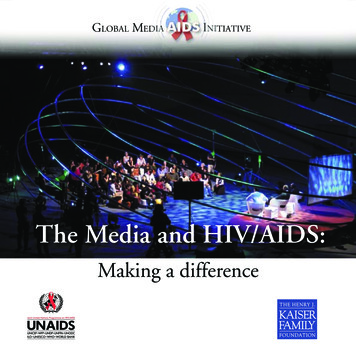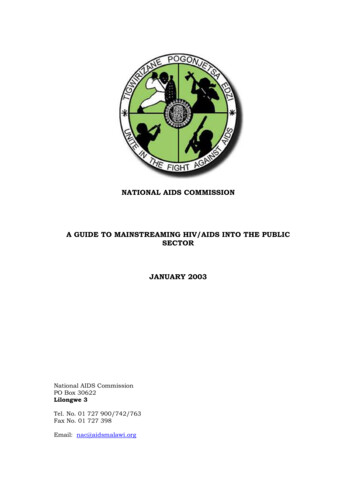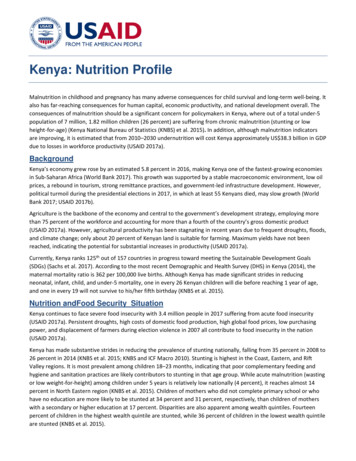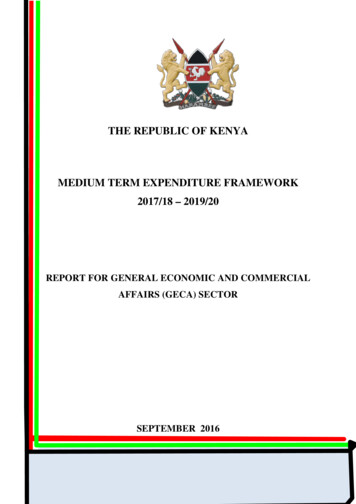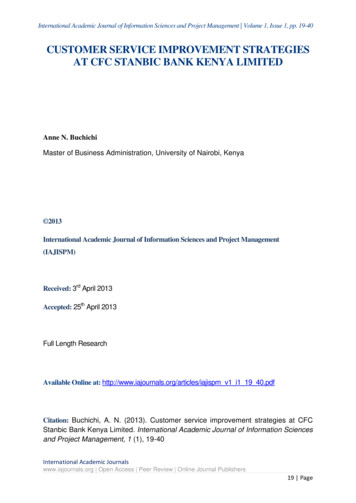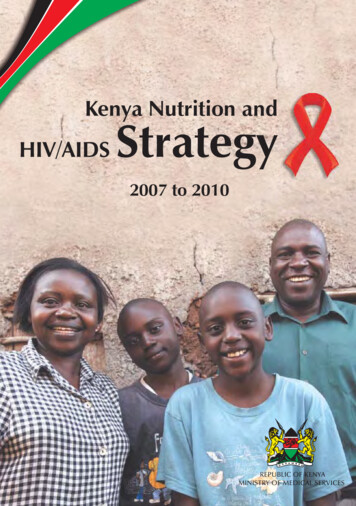
Transcription
Kenya Nutrition andHIV/AIDSStrategy2007 to 2010REPUBLIC OF KENYAMINISTRY OF MEDICAL SERVICES
REPUBLIC OF KENYAMINISTRY OF MEDICAL SERVICESKenya Nutrition andHIV/AIDS Strategy2007 to 2010August 2008
Kenya Nutrition and HIV/AIDS StrategyFunded by: UNICEF Kenya, USAID Nairobi, FANTACopyright @ 2008, Ministry of Medical Services, Government of KenyaEnquiries regarding these Kenya Nutrition and HIV/AIDS Strategy should be addressed to:Director, National AIDS and STI Control Programme (NASCOP)Ministry of Medical ServicesP.O. Box 19361Nairobi, KenyaTelephone254 20 2729502/2729549Email: headnascop@iconnect.co.keWebsite: www.aidskenya.orgThe opinions expressed herein are those of the author(s) and do not necessarily reflect the views of theU.S. Agency for International Development or those of UNICEF Kenya.*Photo on Front Cover courtesy of UNICEF/Georgina CranstonunicefFOOD ANDNUTRITIONTECHNICALASSISTANCE
Table of ContentsForewordList of vChapter 1Introduction1.11.21.31.4Conceptual perspectiveContextual perspectivePurpose and scopeStrategy development process1123Chapter 2Situation Analysis2.1Overview of HIV/AIDS health service providers52.1.1National response52.1.2Health services delivery system52.2Overview of national nutritional targets62.3Progress in implementation of nutrition and HIV/AIDS interventions72.4Gaps in implementation of nutrition Interventions8Chapter 3Guiding Principles and Strategic Objectives3.1Guiding principles133.2Goals and strategic objectives13Strategy for Nutrition and HIV/AIDS 2007-2010(i)
Table of Contents (Continued)Chapter 4Financing the Strategy4.1Costing implementation of interventions194.2Strategy financing estimates20Chapter 5Monitoring, Evaluation and Research5.1Monitoring and evaluation235.2Research and dissemination23ANNEX 1: Framework for the national nutrition intervention in HIV/AIDS25ANNEX 2: Health facilities and services26ANNEX 3: Health facilities by province27ANNEX 4: Results framework for 2007- 201028ANNEX 5: Estimated financing requirements31ANNEX 6: Rationalisation of therapeutic and supplemental food interventions39ANNEX 7: Commitments for nutritional commodities during FY 2007/0840ANNEX 8: Programme M&E draft framework and indicators for nutrition and HIV/AIDS strategy 41ANNEX 9: Bibliography(ii)Strategy for Nutrition and HIV/AIDS 2007-201042
ForewordThe national HIV/AIDS programmes are guided by the Kenya's National AIDS Strategic Plan (KNASP) and the NationalHealth Sector Strategic Plan II (NHSSPII) for 2005 2010. These plans provide an action framework for the nationalresponse to priority areas of the epidemic as well as goals and targets for respective interventions. From thesecorporate plans, the National AIDS/STI Control Programme (NASCOP) along with stakeholders in nutrition care andsupport have developed a business plan with a nested functional strategy to guide nutrition interventions during theremaining plan period.Globally, the ravages of the pandemic on productivity and purchasing power have heightened the risk of malnutritionamong infected and affected persons. Furthermore, reduced access to adequate quality food, poor appetite due todisease or medications, increased energy demands, and malabsorption associated with HIV disease progression causemalnutrition. High rates of malnutrition among eligible antiretroviral therapy (ART) patients and emerging evidenceon the significance of moderate and severe malnutrition as an independent predictor of mortality of people living withHIV/AIDS (PLWHA) underline the need to scale up nutrition interventions. With improved understanding of therelations between HIV disease and nutrition, prevention and correction of malnutrition are now universally integratedinto the response to the HIV/AIDS pandemic to reduce the rates of malnutrition and associated morbidity andmortality as well as improve responsiveness, effectiveness and treatment outcomes.The 2006 national HIV/AIDS statistical estimates indicate significant scale up of ART and prophylactic therapy. Withfirst line interventions scaled up to national level, compelling knowledge and experience in nutrition care and supportrequire consolidation and scale up to ensure realisation of the goals and targets agreed upon in KNASP and NHSSPII.This strategy operationalises the scale up of nutrition interventions in HIV/AIDS by Kenya's government, developmentpartners and stakeholders. In this regard, the strategy has been developed through a participatory process and multisectoral approach to facilitate mainstreaming for sustainability and equitability. The government fully appreciatescontributions and participation by development partners and other stakeholders in preparing the strategy and forsupporting ongoing nutrition interventions. We appeal to other partners and stakeholders to join this partnership toensure that the targets agreed upon in both national and sectoral strategic plans are realised.Hon. Prof. Anyang' Nyong'o EGH MPMinister of Medical ServicesStrategy for Nutrition and HIV/AIDS 2007-2010(iii)
List of Contributors1.Rosemary Ngaruro, Division of Nutrition/MOH2.Mary Wachira, NASCOP3.Ann Mbugua, KNH4.Anne Awori, KEFAN5.Anne Mwangi Thuo, KMTC6.Anne Njuguna, NASCOP7.Assumpta Mureithi, World Health Organization8.Brian Njoroge, USAID/Insta Products (EPZ)9.Earnest Muyunda, FANTA/AED10.Edna Warentho, KNH11.Emily Rotich, MoiTeaching and Referral Hospital12.Esther Waihenya, Kenya Medical Training College13.Esther Wamai, FANTA/AED14.Faith Gitahi, KNH15.Faith Thuita, UNICEF16.Fanice Komen Towett, Moi University AMPATH17.Hanna Tadayo, NASCOP/Capacity Project18.Hongo T. Amolo, Division of Nutrition/MOH19.Immaculate Anyango, PNO Nairobi20.Lina Njoroge, Kenyatta Hospital21.Linda Beyer, UNICEF Kenya22.Mildred Mudanyi, CDC23.Patrick Mureithi, NACC24.Robert Mwadime,FANTA/AED25.Ruth Akelola, WFP26.Teresa Tumwet, Ministry of Agriculture27.Teresia Mutuku, JHPIEGO28.Terry Wefwafa , Division of Nutrition/MOH29.Valarie Wambane, Division of Nutrition/MOH30.Veronica Kirogo, Ministry of Agriculture(iv)Strategy for Nutrition and HIV/AIDS 2007-2010
AcknowledgementsThe National AIDS/STI Control Programme of the Ministry of Health wishes to acknowledge all those whocontributed to the development of this strategy. The efforts and commitment of the Nutrition and HIV/AIDS TechnicalWorking Group and the participants who attended the stakeholder meetings are gratefully acknowledged. TheUNICEF Kenya country office and FANTA/AED are applauded for supporting stakeholder meetings and preparing thestrategy, respectively. The overall coordination of the process was provided by Dr. I. Mohammed, the Head ofNASCOP and Nutrition Manager Ms. Mary Wachira. Technical direction was provided by Dr. E. Muyunda, Dr. R.Mwadime, Mr. T. Castleman and Ms. E. Wamai of FANTA/AED and Ms. N. Prendiville (Nutrition Section, Head,UNICEF Kenya) and Ms. L. Beyer (Nutrition Specialist, HIV/AIDS, UNICEF Kenya). Dr. D. Mwaniki of Kenya MedicalResearch Institute facilitated completion of the strategy.Completion of this strategy was made possible by the generous support of the American people through the supportof the Office of Health, Infectious Disease, and Nutrition, Bureau for Global Health, United States Agency forInternational Development (USAID) and USAID/Kenya under terms of Cooperative Agreement No.HRN A 00 9800046 00, through the FANTA Project, operated by the Academy for Educational Development (AED). The contentsare the responsibility of AED and do not necessarily reflect the views of USAID or the United States Government.Strategy for Nutrition and HIV/AIDS 2007-2010(v)
SummaryThe Kenya National HIV/AIDS Strategic Plan (KNASP) and the National Health Sector Strategic Plan II (NHSSP II) for2005 2010 provide the framework for the country's response to the HIV/AIDS epidemic. The nutrition and HIV/AIDSagenda is driven by the three priority areas in the KNASP, but the main priority is improvement of the quality of life ofpeople infected and affected by HIV/AIDS (Priority Area 2). The goal of nutritional interventions is to improvenutrition, health, quality of life and duration of survival of people infected with HIV. The targets for the period includestrengthening the capacity of service providers to ensure that over 75 percent of PLWHA receive nutrition educationand counselling and raising the proportion of hospitals that offer therapeutic nutritional care to 80 percent. This isintended to ensure provision of appropriate nutritional care, including supplements to all PLWHA who are eligible toreceive them. Under mitigation of the impact of the epidemic, the health and nutrition needs of orphans andvulnerable children (OVC) are a key component of the livelihood target.The Technical Working Group for Nutrition and HIV/AIDS and stakeholders held a series of consultation workshopsunder the aegis of NASCOP to identify strategies and targets that will drive the nutrition plan of action for the period2007 2010. The purpose of this strategy is to accelerate mainstreaming of nutritional interventions in HIV/AIDSpolicies and programmes and to address key nutritional concerns of OVC with a view to realise full scaleimplementation at the national level. The strategy is intended to guide a two prong mainstreaming approach,namely:(a)Sensitising policymakers about the critical role that food and nutrition security plays and advancing nutritionand HIV/AIDS as a priority on the health agenda(b)Identifying nutrition interventions for integration into HIV/AIDS policies and programmes, and incorporatingHIV/AIDS in food and nutrition policies and programmesThe strategy seeks to consolidate gains made, expand areas of operation in the scale up to the national level andensure synergy. In this regard, the plan and budget estimates for implementing this strategy were determined underthese areas of operation: development and production of training and educational materials, human resourcescapacity strengthening, quality assurance and standards, communications and advocacy, coordination andcollaboration, dietary commodity support, research and dissemination, and monitoring and evaluation (M&E). Ofnote is the alignment of these areas to existing structures and programmes to ensure efficiency and effectiveness.Critically important is the need to ensure detailed operations plans, adequate resources, commitment by allstakeholders and an efficient M&E system. The identified operations will require a total of Ksh 6.4 billion during thethree year period, an annual estimate of Ksh 2.1 billion. Eighty four percent of this budget will go toward therapeuticand supplemental foods and micronutrient supplements for treatment of malnutrition and prophylactic support. Italso is critically important to integrate the strategy in the annual operations plans and the medium term expenditureframework of the health sector and other relevant sectors for sustainability, and to keep the strategy alive so thatresource gaps can be addressed through emerging opportunities and innovations.(vi)Strategy for Nutrition and HIV/AIDS 2007-2010
AcronymsAASatomic absorption spectrophotometerACUAIDS control unitAEDAcademy of Education DevelopmentAMPATHAcademic Model for the Prevention and Treatment of HIVAPHIA IIAIDS, Population and Health Integrated AssistanceARapplied researchARTantiretroviral therapyASALarid and semi arid landBFFblended fortified flourBMIbody mass indexCACCConstituency AIDS Control CommitteeCCCComprehensive Care CentreCDCCentres for Disease Control and PreventionCHEWcommunity health extension workersCOBPARCommunity Based Programme Activity ReportingCORPScommunity owned resource personsCSOcivil society organisationsD/CHDivision of Child HealthDFIDDepartment for International DevelopmentD/NutDivision of NutritionD/RHDivision of Reproductive HealthD/SRSDivision of Sector Reform SecretariatDDCDistrict Development CommitteeDSCDistrict Sectoral CommitteeDSGDistrict Steering GroupEPZexport processing zoneERSEconomic Recovery StrategyESAROEast and Southern Africa Regional OfficeFANTAFood and Nutrition Technical AssistanceFAOFood and Agricultural OrganisationFBOfaith based organisationsFBPfood by prescriptionGIPAgreater involvement of people with HIV/AIDSGLIAGreat Lakes Initiative on HIV/AIDSGoKGovernment of KenyaHBChome based careHMIShealth management information systemHPLChigh performance liquid chromatographStrategy for Nutrition and HIV/AIDS 2007-2010(vii)
Acronyms (Continued)ICCInteragency Coordinating CommitteeICTinformation and communication technologyIECinformation, education and communicationIMCIintegrated management of childhood illnessIYCFinfant and young child feedingJAPRJoint Annual Programme ReviewJICCJoint Interagency Coordinating CommitteeKANCOKenya NGOs ConsortiumKARIKenya Agricultural Research InstituteKARSCOMKenya HIV/AIDS Research Coordinating MechanismKEBSKenya Bureau of StandardsKECOFATUMAKenya Consortium to Fight AIDS, TB and MalariaKEFANKenya Food and Nutrition NetworkKEMRIKenya Medical Research InstituteKEPHKenya Essential Package for HealthKFSMKenya Food Security MeetingKFSSGKenya Food Security Steering GroupKIEKenya Institute of EducationKIRACKenya Inter Religious AIDS ConsortiumKMTCKenya Medical Training CollegeKNASPKenya's National AIDS Strategic PlanKNHKenyatta National HospitalM&Emonitoring and evaluationMEDSMission for Essential Drugs and SuppliesMGCSSSMinistry of Gender, Culture, Sports and Social ServicesMMNmultiple micronutrientsMoAMinistry of AgricultureMoEMinistry of EducationMoHMinistry of HealthMoLFDMinistry of Livestock and Fisheries DevelopmentMoHAMinistry of Home AffairsMoYAMinistry of Youth AffairsMSFMédecins Sans Frontières (MSF)MTEFMedium Term Expenditure FrameworkMUACmiddle upper arm circumferenceNALEPNational Agriculture and Livestock Extension ProgrammeNASCOPNational AIDS/STI Control ProgrammeNEPHAKNational Empowerment Network of People Living with HIV/AIDS in Kenya(viii)Strategy for Nutrition and HIV/AIDS 2007-2010
Acronyms (Continued)NGOnon governmental organisationNHSSPIINational Health Sector Strategic Plan IINPHLSNational Public Health Laboratory ServicesOPOffice of the PresidentORoperations researchOVCorphans and vulnerable childrenPATHProgram for Appropriate Technology in HealthPEPFARThe President's Emergency Plan for AIDS ReliefPLHWApeople living with HIV/AIDSPMTCTprevention of mother to child transmissionPNOprincipal nursing officerPPPpublic private partnershipsPSIPopulation Services InternationalRUTFready to use therapeutic foodSTIsexually transmitted infectionTBtuberculosisTOTtraining of trainersTOWATotal War Against HIV/AIDSTWGtechnical working groupUNICEFUnited Nations Children's FundUoNUniversity of NairobiUSAIDUnited States Agency for International DevelopmentVCTvoluntary counselling and testingWFPWorld Food ProgrammeWHOWorld Health OrganisationStrategy for Nutrition and HIV/AIDS 2007-2010(ix)
Chapter 1:INTRODUCTION
1.1 Conceptual PerspectiveAn effective response to the HIV/AIDS epidemic in Kenya requires an enhanced ability to ensure the food andnutrition security of individuals and communities to complement other established interventions. According to theKenya National HIV/AIDS Strategic Plan (KNASP) for 2005 2010, 75 percent of PLWHA will receive nutritioneducation and counselling, and appropriate food nutritional supplements will be provided to all who need them.These targets were set to facilitate realisation of the national goals of improving the quality of life of people infectedand affected by HIV/AIDS. In this regard, the Kenya Essential Package for Health (KEPH), under the National HealthSector Strategic Plan II (2005 2010) identified improvement of nutrition support services as a key area of intervention.The targets are to provide nutrition support services in ART centres and to raise the proportion of hospitals offeringtherapeutic nutritional care to 80 percent.In the past two years, significant progress has been made toward realisation of these objectives. Midway in the planperiod, achievements are below the targets set by both KNASP and NHSSP II. To roll out required interventions, theMoH, through NASCOP, development partners and stakeholders, developed a business plan for nutritioninterventions in HIV/AIDS. The Kenya Nutrition and HIV/AIDS Strategy provides a framework for acceleratingprogress toward improving the nutritional status of PLWHA in Kenya by preventing malnutrition, improving nutritionand reducing the impact of the pandemic on individuals and communities.1.2 Contextual PerspectiveIn the Economic Recovery Strategy (ERS), the HIV/AIDS agenda underlines the government's decision to set up specialhealth care programmes for PLWHA, train communities on HIV/AIDS home based care, implement the HIV/AIDScurriculum in all schools and strengthen the health sector's response to HIV/AIDS by forming Constituency AIDSControl Committees (CACC). Under the nutrition agenda, the ERS spells out the decision to carry out awarenesscampaigns on the benefits of improved nutrition and promote production and consumption of nutritious food. In thisrespect, the draft sessional paper on Food Security and Nutrition Policy (2007) underlines the negative impact of highprevalence of HIV/AIDS on the country's socioeconomic development and calls for specific actions to mitigate theimpact of the scourge.These policy decisions are based on the fact that HIV infection affects nutrition through reduction in dietary intake,nutrient malabsorption/wastage and complex metabolic alterations that culminate in weight loss, wasting, disruptionof fat and bone metabolism and changes in micronutrients levels due to loss or sequestration in response toinflammation. Breaking the cycle of poor nutrition and infection among PLWHA will prevent new infections, improvequality of life and mitigate the socioeconomic impact of HIV/AIDS. Furthermore, nutrition is increasingly beingadvocated as an adjunct in ART. These recommendations are based on the need to improve immune reconstitutionand adherence to treatment, and on the potential role of nutrition interventions in prolonging the pre ART stage.Outside the rationale related to quality of life, poor food and nutrition security spurs risky behaviour that acceleratesthe spread of HIV infection. Thus, nutrition and food security play across all three areas of KNASP, namely preventionof transmission, enhancement of quality of life and mitigation, especially for OVC and affected families.1Strategy for Nutrition and HIV/AIDS 2007-2010PREVIOUS PAGE PHOTO CREDIT: UNICEF/SARA CAMERON
Among children, HIV infection causes growth faltering even before the onset of the infection's symptomatic phase.This hinders child development and is associated with increased risk of mortality. Interventions aimed at improvingdietary intake are essential to enable infants and young children to cope with infections and regain lost weight, sothese interventions are a priority. In this regard, policy guidelines on prevention of mother to child transmission(PMTCT) for infant and young children feeding (IYCF) have been developed (MoH, 2004). With improved childsurvival, focusing on the nutritional needs of older infected children is also important. In addition, while WHOstandards for children age 0 14 years can be adapted, indicators and cutoff points that are specific to 5 to 13 year oldswill be required in further development of the OVC component.Universal access of PLWHA and those affected to nutritional support programs is a key indicator of success in the fightagainst the epidemic. Kenya's main gap in the realisation of universal access to nutritional care and support is the weakintegration of nutrition interventions in HIV/AIDS policies and programmes and in the national health care services ingeneral. The slow scaling up of nutritional support programmes is partly attributed to inadequate evidence of theimpact of nutritional interventions on adherence to ART and compliance to care plans and the impact of the nutrientformulation of food supplements and nutraceuticals that are commonly recommended for PLWHA, as well as thefeasibility of incorporating nutrition supplements into treatment and care programs. Moreover, inadequacies inhealth care systems with respect to personnel, equipment and supplies along with insufficient information andtraining at all levels on topics related to nutrition care of PLWHA and those affected by HIV/AIDS remain majordrawbacks.1.3 Purpose and ScopeThe nutrition and HIV/AIDS strategy aims at developing model strategies to be implemented by institutions andorganisations who provide services involved in the national response to the epidemic and by policymakers whosupport such institutions. The strategy describes activities and functions for the organisations and institutions to ensureefficient and effective delivery of food and nutritional services and to ensure that they influence the quality of life andsurvival of infected and affected persons.PurposeThe purpose of the nutrition and HIV/AIDS programme strategy is to accelerate mainstreaming of nutritionalinterventions in HIV/AIDS policies and programmes with a view to making them an integral part of the nationalresponse at all levels of programming based on the following:(a)(b)(c)(d)Articulating strategic priorities in food and nutrition for the Kenyan response to HIV/AIDS to ensure thatnutrition support services are directed at those areas that are likely to realise highest benefits for PLWHAConsolidating achievements and improving the quality and coverage of services and institutionalising keyactivities within the national HIV/AIDS management frameworkIdentifying the roles of the various key players in the national response in the development and implementationof nutrition and HIV/AIDS interventionsDefining processes and inputs necessary for the timely realisation of the national targetsThe nutrition and HIV/AIDS programme strategy will be aligned with the sectoral programmes that are directlyinvolved in mainstreaming the fight against the epidemic and with considerations for the national food security andnutrition policy session paper, along with other relevant policies and regulations.Strategy for Nutrition and HIV/AIDS 2007-20102
ScopeThe strategy defines the actions required in mainstreaming and the roles and functions of various key players. Itexcludes details of functions of intermediaries and groups such as community based organisations (CBOs). Althoughthe strategy is aimed to influence all stakeholders in the HIV/AIDS response, some of the functions it prescribes mightnot be feasible for small civil society organisations (CSOs) and faith based organisations (FBOs). It is recommendedthat all actors strive to implement elements of the strategy where feasible to reach all PLWHA and affected people,especially OVC.1.4 Strategy Development ProcessThe strategy was developed from a review of the current constraints and opportunities and identifies objectives, goalsand the activities to be implemented to achieve national goals stated in KNASP. The development of the strategy wascommissioned through a series of stakeholder workshops organised by NASCOP in 2007. The National TechnicalWorking Group (TWG) on Nutrition and HIV/AIDS comprising sub sector representatives from line ministries,public institutions, private sector and associations, and development partners was requested to drive the strategyformulation process. A participatory approach and consultative process with the key stakeholders, along withexpanded representation of views were used to gain high level buy in and ownership of the strategy. Serviceproviders from different sections of the agriculture, health, academic and private sectors and CSOs; developmentpartners; and users were involved or consulted during the process. Key partners such as USAID, FANTA/AED, CDC,UNICEF and WHO were also engaged. The workshops were also aimed at raising awareness to drive consensus onmainstreaming nutrition and HIV/AIDS in policy and programmes designed to fight the epidemic.The output of the workshops was used as the basis for developing this strategy. The TWG provided additional inputs tothe strategy design and formulation through consultations, gathering of data on critical issues and validation of thestrategy proposals.Completing the strategy involved these steps: Distribution of the draft document to all workshop participants for commentReview of all comments received by the steering committeeDistribution of the edited version to a wider scope of key role players and interested parties for commentConsolidation and final review based on all comments from the TWG3Strategy for Nutrition and HIV/AIDS 2007-2010
Chapter 2:SITUATION ANALYSIS
2.1 Overview of HIV/AIDS Health Service Providers2.1.1 National ResponseThe core principles of the national response strategy include adoption of a multi sectoral response, the targeting ofevidence based interventions to the most vulnerable and/or special groups, meaningful involvement of PLWHA andthe empowering of stakeholders to participate effectively. The institutional framework to support the nationalresponse strategy is shown in Annex 1.2.1.2 Health Services Delivery SystemHealth FacilitiesThe types of facilities in Kenya include clinics, dispensaries, health centres, nursing homes, hospitals and stand alonevoluntary counselling centres. Currently, there are 5,165 facilities in total. Dispensaries and clinics account for 77percent of these facilities. Hospitals (301), health centres (660) and nursing homes (189) account for 17 percent of thehealth facilities. Among hospitals, 158 are run by the Government of Kenya (GoK) government and the remainder areeither mission (70), private (70) or NGO (three) hospitals. Overall, government runs 46 percent of these healthfacilities. Government hospitals provide inpatient care to more patients than all other providers combined. Forexample, in 2006, admissions to government hospitals accounted for 63 percent of all admissions in the country.Services central to HIV/AIDS counselling and testing services, PMTCT, ART and home based care are available in471 public facilities and 342 non government facilities. In all, however, there are 350 established ComprehensiveCare Centre (CCC) facilities. In line with KEPH levels, the rest are treatment centres. The distribution of governmentand non government facilities providing intervention services for HIV/AIDS and TB treatment are shown in Annex 2.Of significance are the policy decisions to decentralise treatment, care and support services for PLWHA to treatmentcentres and the establishment of stronger linkages with community and home based care programmes.Human ResourcesAvailable estimates indicate that there are 5,700 registered doctors, 9,000 clinical officers and 28,000 nurses in activeservice. The public sector is currently served by an estimated 1,960 doctors, 4,000 clinical officers, 16,227 nurses and700 nutritionists, meaning that the majority of these front line cadres are serving in the non government healthsector.Multi-sectoral ConsiderationsThe Ministries of Agriculture (MoA), Livestock and Fisheries Development (MoLFD), Education (MoE) and Gender,Culture, Sports and Social Services (MGCSSS), Home Affairs (MoHA) and Youth Affairs (MoYA) have elaboratecommunity/extension services that are highly mobile and readily available to the community. Within the context ofexternal mainstreaming of HIV/AIDS, these service providers have unique opportunities to enhance their servicesthrough integration of specific interventions in their respective community programmes. For example, the NationalAgriculture and Livestock Extension Programme (NALEP), which has high mobility and day to day contact with rural5Strategy for Nutrition and HIV/AIDS 2007-2010PREVIOUS PAGE PHOTO CREDIT: UNICEF/SARA CAMERON
community, should play a major role in alleviating food insecurity. The culture and sports sectors have responsibilitiesand means to tackle unfavourable cultural norms and influence traditional healers and youth through sports. The MoEis the lead agency in informing and educating youth in schools and adults through the adult education programme.Other key public sector actors include the MoHA's Children's Department, which is the lead agency in coordinatingOVC support programs. The MoYA provides a tremendous opportunity for advancing youth targeted HIV/AIDSinterventions in the country. Under MGCSSS, the government's push for greater empowerment of women providesanother opportunity to enhance their coping capacity.NGO SectorProvisional analysis of reports from 11,506 NGO implementers of HIV/AIDS interventions in the country indicatesthat 73 percent provide nutrition support to PLWHA and affected persons. These services were provided in homesand drop in centres that serve meals to clients. Only 11 implementers reported that they were carrying out growthmonitoring of children under five years old. However, details of the package, quality and effectiveness of services thatthey provide have not been established. Nevertheless they provide a useful link between facilities and the communityin treatment, care and support especially under the home based care programme as well as mitigation.2.2 Overview of National Nutritional TargetsThe main malnutrition concern among PLWHA is undernutrition. (Details of predisposing factors and possibleinterventions are provided in the NASCOP nutrition and HIV/AIDS counselling cards, among other references.)Undernutrition among PLWHA is a priority concern even with the scale up of care and treatment programs in Kenya.Data from the ongoing Food by Prescription (FBP) programme and UNICEF's nutrition interventions for PLWHAsuggest that prevalence of undernutrition (BMI 18.5) among adults reporting for care and treatment in CCCs for thefirst tim
CACC Constituency AIDS Control Committee CCC Comprehensive Care Centre CDC Centres for Disease Control and Prevention CHEW community health extension workers COBPAR Community Based Programme Activity Reporting CORPS community owned resource persons CSO civil society organisations D/CH Division of Child Health DFID Department for International .

